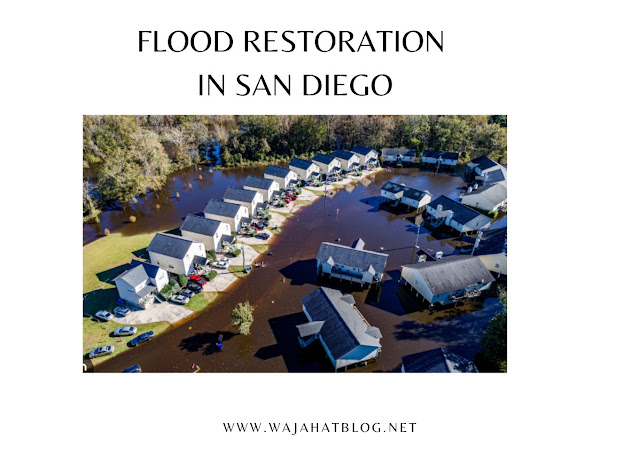Flood Restoration in San Diego: The Ultimate Guide to Swift and Effective Flood Restoration
Introduction
Flood
restoration is an essential undertaking in San Diego, considering the region's
susceptibility to flooding. Here, we will explore the immediate impacts of
flood damage and stress the importance of acting promptly to mitigate further
harm.
Understanding
Floods in San Diego
San
Diego is no stranger to floods, and understanding the characteristics and
common causes of these events can help homeowners better prepare. By
identifying flood-prone areas, individuals can take necessary precautions and
safeguard their homes.
Before
Restoration: Emergency Preparedness
In
anticipation of potential flooding, it is crucial to create a comprehensive
emergency plan. This plan should outline evacuation routes and establish
contact with emergency services. Additionally, securing important documents and
possessions will ensure their safety in the event of a flood. Familiarizing
yourself with the details of your insurance coverage will also alleviate stress
during the restoration process.
The
Flood Restoration Process
Before
diving into flood restoration, an initial assessment of the situation is
necessary to establish safety precautions. Hiring a professional flood
restoration company is highly recommended, and evaluating their credentials,
experience, licenses, and certifications is paramount. These experts will come
equipped with the necessary tools and equipment needed for a thorough
restoration plan.
Swift
Response and Mitigation Strategies
As
floods can be catastrophic, acting swiftly is crucial. Turning off the
electricity, gas, and water supply is the first step to ensure safety. Removing
excess water from the affected area should follow, as it will help minimize
damage. Salvaging valuable items and furniture is also a priority, along with
implementing temporary repairs to prevent further harm.
Thorough
Cleaning and Sanitization
After
the removal of debris and mud, the space should be thoroughly dried and
dehumidified to prevent secondary damage. The next step involves cleaning and
disinfecting surfaces affected by the flood. Attention to mold prevention and
remediation throughout this process is key to prevent future health hazards.
Restoring
Structural Integrity
The
structural integrity of walls, floors, and foundations must be evaluated for
damage. Electrical systems should also be inspected to ensure safety. Based on
these assessments, repair or replacement of damaged structural elements should
be undertaken by professionals.
Restoring
Indoor Environment Quality
Aesthetics
and functionality are not the only concerns in flood restoration; addressing
air quality is equally important. To achieve this, thorough removal of odors
and pollutants is necessary. Proper ventilation and moisture control should
also be implemented to prevent mold growth and ensure a healthy indoor
environment.
Salvaging
and Restoring Personal Belongings
Assessing
the damage inflicted on furniture, appliances, and electronics is paramount. By
cleaning and restoring salvageable items, homeowners can potentially save
treasured possessions. Proper disposal of irreparable belongings should be
handled responsibly, following environmental guidelines.
Flooring
Restoration and Replacement
Different
flooring materials may react differently to floods, requiring precise
evaluation of the damage incurred. Upon assessment, restoration or replacement
of damaged flooring should be done meticulously, considering materials that
enhance future flood resilience.
Final Touches
and Aesthetics
Once
the structural elements are secured, attention can be directed towards
restoring the aesthetics of the space. This involves painting and repainting
walls, as well as repairing any damaged fixtures and fittings. Ultimately, these
final touches will contribute to the overall restoration outcome.
Ensuring
Long-Term Protection
To
minimize the risk of future floods, installing flood-resistant barriers and
materials is highly recommended. Updating insurance policies and coverage is also
vital to ensure proper compensation in case of recurring incidents. Regular
maintenance and inspections should become routine to prevent future floods from
causing significant damage.
Summary
and Conclusion
By
recapping the crucial tips mentioned throughout this guide, individuals can
achieve swift and effective flood restoration in San Diego. It is essential to
acknowledge the importance of professional assistance during the restoration
process, as their expertise and experience are invaluable. Prioritizing flood
preparedness will ultimately lead to a proactive approach to mitigating damage.
FAQs
(Frequently Asked Questions)
A. How
long does the flood restoration process typically take?
The
duration of the restoration process varies based on the extent of the damage.
While some small-scale restorations may take a few days, larger projects may
take weeks.
B.
Will insurance cover all the flood restoration costs?
The
extent of coverage depends on individual insurance policies. It is crucial to
thoroughly review your policy to understand what expenses will be covered.
C. Can
I perform flood restoration by myself without hiring professionals?
While
minor cleanup tasks may be manageable, professional assistance is strongly
advised for comprehensive restoration. Professionals have the necessary skills,
equipment, and experience to ensure a thorough restoration process.
D. How
can I prevent mold growth after a flood?
Drying
and dehumidifying the affected area promptly is crucial to preventing mold
growth. Moreover, ensuring proper ventilation and cleaning and disinfecting
surfaces will further minimize the risk.
E.
What can homeowners do to minimize the risk of future floods in San Diego?
Installing
flood-resistant barriers and materials can significantly reduce the risk of
future floods. Additionally, regular maintenance and inspections of the
property's plumbing and drainage systems are advisable.
F. Are
there any government assistance programs available for flood restoration in San
Diego?
Depending
on the nature of the flood and its impact, government assistance programs may
be available. It is recommended to research local resources and consult with
relevant authorities for information on potential assistance.
G. Can
flood restoration companies help with water damage caused by leaking pipes?
Yes,
flood restoration companies are equipped to handle water damage caused by
various sources, including leaking pipes. Their expertise extends to addressing
such issues and restoring affected areas appropriately.


.jpg)
Post a Comment
Please do not enter any spam link in the comment box.
Regards